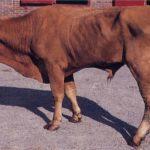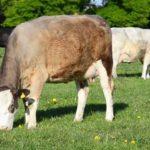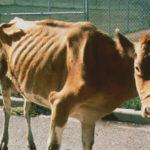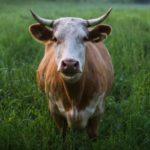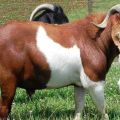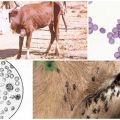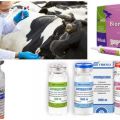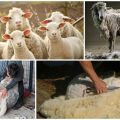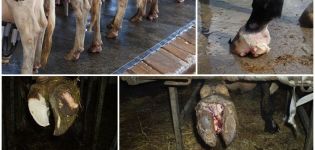Symptoms and diagnosis of paratuberculosis in cattle, instructions for treatment
Infectious diseases of cows can cause significant harm to livestock, as they worsen the health of animals and can lead to death. Consider the causes and signs of cattle paratuberculosis, methods of diagnosing the disease and preventive measures that need to be taken to reduce the likelihood of the spread of infection in your household.
What is paratuberculosis
Bovine paratuberculosis is a chronic infectious disease of ruminants. The causative agent is the bacteria Mycobacterium paratuberculosis, obligate parasites that are resistant to the negative effects of external factors and disinfectants. The disease proceeds mainly in a latent form, that is, without pronounced symptoms; in the clinical course of the disease, the disease can end with the death of the animal in 2-4 months.
Sources and routes of infection
Bacteria enter the body of cows with food, which is contaminated with fecal matter and the secretions of sick animals, since in cows with paratuberculosis, the intestines are affected. Mycobacteria can end up in animal care equipment and can contaminate pastures, water sources, fodder and buildings. Calves become infected through milk from sick mothers, and can also be born already infected.
The release of parasites from the body of sick animals begins 3-5 months after infection. Paratuberculosis is dangerous because many animals are asymptomatic, which is why they do not differ in appearance from healthy ones, but are carriers of bacteria.
Outbreaks of paratuberculosis can occur at any time of the year. A large number of diseases are recorded in regions where there are acidic, moist or saline soils, which is explained by the fact that the plants grown on such soils are poor in calcium and phosphorus salts.

The likelihood of developing paratuberculosis increases when cows are fed with acidic feed, for example, silage, with worm infestations, after hypothermia or overheating of animals. Cows can get sick during the acclimatization period or when kept in unusual conditions.
Disease symptoms
The incubation period of paratuberculosis can last from several months to 1 year. Latently sick cows lag behind in growth, lose weight, and fatness is not restored. Those animals that are distinguished by good body resistance and which eat normally and receive good maintenance can recover on their own. Latent disease turns into clinical form for various reasons that reduce the resistance of the cows' organism.
Clinical signs of paratuberculosis are manifested mainly in young animals 3-5 years old, which have already had 1 or 2 calving.
Paratuberculosis can be determined by its first signs, such as a decrease in milk yield, the appearance of edema under the jaw and in the dewlap, and progressive exhaustion. Diarrhea occurs periodically in animals, over time it becomes persistent. Feces of a liquid consistency, have an unpleasant odor, lumps of mucus can be seen in them, rarely - blood and gas bubbles. Animals eat normally, do not lose their appetite, but due to dehydration, they begin to drink more water. There is no increase in temperature and pain.
The cow loses weight, muscle mass decreases, especially on the croup and hind legs. This reduces the economic value of the animal.
Diagnosis of the disease
The diagnosis - paratuberculosis - is made by epizootic and clinical signs, according to the results of allergic tests and laboratory bacterioscopic studies for the presence of the pathogen. Additionally, another study is used - the complement binding reaction.
Pathological changes in paratuberculosis affect the small intestine, its back. Typical symptoms are 5-10-fold thickening of the mucous membrane in the affected area. There is a narrowing of the intestinal lumen, clearly visible in the cross section. On the longitudinal one, a clear longitudinal and transverse folding is visible; when stretched, the folds do not disappear. Lymph nodes on the mesentery and ileocecal valve are enlarged, elastic, moist on the cut, gray-yellow in color.
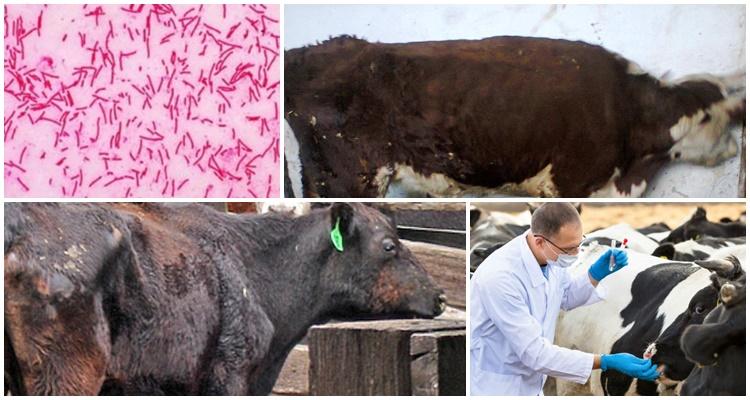
Some sick animals may have edema of the serous membrane of the mesentery and intestines, enlarged lymph nodes, partial enlargement and partial atrophy of intestinal villi.
Treatment of paratuberculosis in cattle
No specific treatment for paratuberculosis has been found, therapy for the disease is considered ineffective, since no recovery occurs. Sick animals are slaughtered, damaged organs are disposed of, meat can be eaten. According to the instructions, animals that have a positive reaction to tuberculin are separated from the general herd and raised separately. Young animals obtained from them can be raised for meat, but they are not suitable for breeding.
Prevention
In areas affected by paratuberculosis, cows are periodically examined. Animals with visible symptoms are slaughtered. All the rest, who have already turned 1.5 years old, are diagnosed with the help of RSK. Those who have positive samples are also handed over for slaughter, with negative results left in the herd. These cows are then examined by the same method twice a year.
Calves up to 1.5 years old are raised separately from the rest of the herd. They are fed milk from healthy animals or milk from those that test positive but have no clinical signs of paratuberculosis. Such milk is pre-pasteurized.
It is necessary to acquire new animals for recruiting the herd only from farms that are free from this disease, because it is not always clear that a cow or a calf is sick. Animals should be fed and cared for in accordance with zoological requirements. After the manure has been removed, it must be dried and incinerated or biothermally disinfected in compost heaps.
To disinfect the premises where cows are kept, inventory and milking equipment.Slaked lime, sodium hydroxide, formaldehyde, creolin, phenol solution can be used as disinfectants. The barns are disinfected after a livestock survey and after calving. A farm is considered safe for paratuberculosis if it has been sanitized and no sick animals have been identified for 3 years after the last case of the disease.
Bovine paratuberculosis is not treated, sick animals either die or are handed over for slaughter. In order to prevent the spread of the disease within the farm, it is necessary to conduct livestock inspections, do tests, make sure that it is possible to raise cows separately from the general herd, if necessary.

